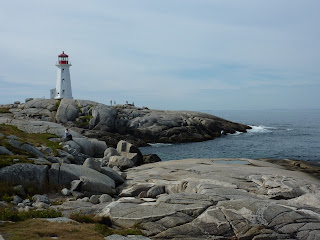Late August...as we drove along the southern shore of the St. Lawrence wending our way to New Brunswick, we were fascinated that every little town we drove through was named after a saint... and featured a two-spired white Catholic church.
Now... two weeks ago, Dan and I had a weekend off and we headed off to Nova Scotia for three wonderful days. Here too, we drove through a countryside replete with churches... not Catholic, however... many Anglican and some Baptist, along with a sprinkling of other denominations.
The churches are rivalled only by the many salt-shaker lighthouses.
The churches are rivalled only by the many salt-shaker lighthouses.
Yes, Nova Scotia is "the sea-bound coast"... and.the old sea-faring song that I learned in school so long ago, rang in my ears as we wound our way around the South Shore.
Our first day, however, was spent in Halifax, and we began with the historic harbour, Canada's gateway to the Atlantic.
One of our goals was to spend some time at Pier 21, Canada`s immigration museum. Here we were able to search for the documents pertaining to both our parents' immigration from Ukraine to Canada in the mid 1920s. With help we found them all. I was particularly delighted to find the passenger list and a photo of Empress of Scotland on which my 21 year old mother, together with her mother and six siblings, sailed from Southampton, England in Sept.1925. They landed in Quebec, as did Dan's parents, but the Halifax museum now houses all the historical immigration records. Between 1928 and 1971 1.5 million immigrants and service personnel passed through Pier 21. The immigrant experience became much more real to us.
Above the harbour sits Halifax Citadel, the hilltop fortress of the 1880s, when Halifax was a key British stronghold. Dan was happy to pose!

From Halifax we began exploring the bays and coves of the scenic South Shore.

We were able to visit the Maritime Museum of the Atlantic (in Halifax on a later date) and the impressive exhibit portraying the great Halifax harbour munitions explosion of 1912, which destroyed the waterfront and several miles into the city of the day. We also watched the National Geographic's amazing underwater film of the remains of the Titanic. Halifax harbour was where hundreds of those who perished washed ashore.
While eating our pasties at Peggy's Cove, we had an engaging encounter with a young woman from Germany (sitting there behind us), who had come, with her three young boys, to experience a year in Canada .
She has rented a house not far from Peggy's Cove, her envious husband joining them on vacations. She was very interested in our sales, and indeed showed up in Halifax two weeks later, to see what Ten Thousand Villages had to offer.
 From there the coastal route took us through the picturesque town of Mahone Bay,and then on to Old Town Lunenberg and the dockyard where the Bluenose II is undergoing a major restoration. The Bluenose, depicted on the Canadian dime, won many races in her time (1921-1946) and will be back sailing in 2012.
From there the coastal route took us through the picturesque town of Mahone Bay,and then on to Old Town Lunenberg and the dockyard where the Bluenose II is undergoing a major restoration. The Bluenose, depicted on the Canadian dime, won many races in her time (1921-1946) and will be back sailing in 2012.On our last day we pulled ourselves away from the south coast and headed for Fundy Shore and the famous Annapolis Valley. Here we were looking for orchards and apples and wineries and were not disappointed.
So, on this note we fare thee well...
Tomorrow we leave for a three day tour of Cape Breton and Celtic Colours!














We would love to join you and explore Cape Breton (or Halifax) with you, but since that won't happen at this time, thank you for sharing photos and description of the experiences. I am glad to know it is not all work but that you also have time to "play". Take care, M & G
ReplyDeleteGreat pictures Mom! What a beautiful part of the country. Makes me want to go back! Were you able to get copies of the immigration records?
ReplyDelete